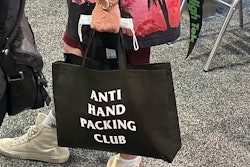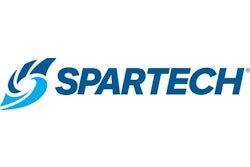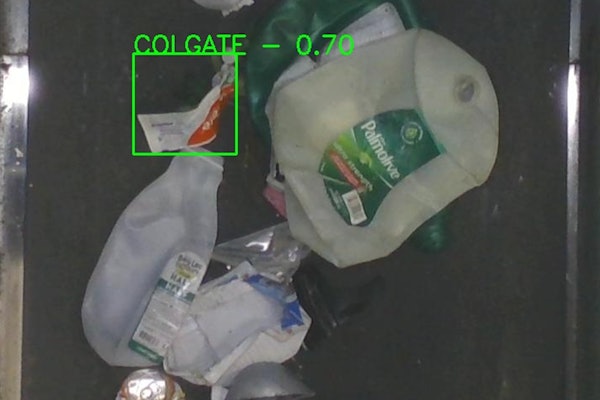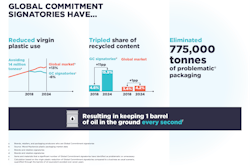Mundo PMMI's Lilián Robayo, OEM's Natalie Craig, Automation World's Dave Greenfield and ProFood World's Melissa Griffen look back at PACK EXPO Las Vegas and Healthcare Packaging EXPO. Together they highlight what they felt were the most impactful takeaways from the show, uncovering everything from new recyclable materials to robots. The group also discusses the ways machinery manufacturers are making equipment easier for new employees to operate, helping to tackle the lack of skilled labor as older employees transition into retirement.
To subscribe, rate, review and find more unPACKED podcast episodes, visit pmmi.org/podcast or find us on Apple podcasts, Spotify or iHeart Radio.
 | Read the full transcript below. |
Sean:
Lilian, we're going to kick things off. What have you seen out there on the show floor that you think the people at home should be aware of and know about?
Lilian:
Thanks Sean. Yes, one highlight for me was the development promoted by the company Serac called Cupbox. Serac is presenting here an onsite unique, intelligent unit for the manufacturing of cups in PET. The company points out that this is the first solution of its class in the market and a technology that is responding to the trends of sustainability and circular economy. What is it about? It is an all-in-one solution in a stretch-blowing, filling and heat-sealing cups in PET in-house, which is interesting because it is responding to an anticipated growth trend and development of the use of PET cups for yogurts and fresh dessert markets and due precisely to the implementation of circular economy around PET.
Sean:
Very cool.
Lilian:
Since blown PET cups are 100% recyclable and can also be made of recycled PET, which is approved for food contact, the company mentions that in the same way that we could have PET closed loops, bottle-to-bottle, with this system we can have cup-to-cup recycled closed loops. Having these applications in packaging, the benefits of PET, which are transparency, lightness, resistance and especially recyclability. "This blown molding technology with filling and sealing --mentioned the Latin American manager, Rodrigo Melo--, is a high precision blowing unit with a linear, volumetric filler for medium to high outputs."
Lilian:
Among the features, this Cupbox can fill simultaneously up to five alternate layers of fruit and yogurt, and mold up to 10 cavities in speeds up to 15,000 PET cups per hour. And also interesting, it offers a good energy efficiency, a good characteristic here because it guarantees a homogeneous heat penetration, thanks to the rotation and ventilation of the preform in the system. I thought it was a very cool sustainability solution.
Sean:
Sustainability is obviously huge. It's something that we're always hoping is going to keep advancing as we can get it more involved in the supply chain. So the closed loop is obviously something we really want to see.
Lilian:
Absolutely, Sean. Regarding materials, I also saw a very nice sustainable solution by the Brazilian company of bio-oriented, flexible polyester films, Terphane, which here at PACK EXPO is promoting the Ecophane line. It's a line that incorporates the concept of circular economy and in line with the growing demand, as we know, for sustainable packaging. These materials for flexible packaging solutions include a recycled PET film produced with at least 30% of PCR or post-consumer recycled PET resin. The company says that these materials offer the same thermal, chemical, and mechanical characteristics of the BOPET films, and are approved by FDA, European Union EFSA, and the Brazilian Sanitary Vigilance Agency (AVINSA) for food contact.
Sean:
Yeah, very nice. As you said, it's going to be something that can be used pretty much around the world.
Lilian:
Absolutely, this is by the Brazilian company Terphane and it has been applied in Europe, in Latin America and in the United States.
Sean:
Very nice.

And while we're on the topic of sustainability, I actually have a really innovative handle that I picked up from PAC tech. I just stopped by their booth and learned that they won a global sustainability award for this. Now, if you go to their booth, you'll see that their handles are usually in a plethora of colors, very bright vivid, eye-catching. This one is actually gray because it's made completely of their recycled handles. It's turned into a resin and then they use these and it just won a sustainability award. So that's...
Sean:
So the other ones that are the color of the ones they make and that one is made as a recycled version of them.
Natalie Craig:
Yes, so when their handles are recycled, they turn it into this resin and because all the colors are mixed together, it creates this kind of gunmetal gray. It may not be colorful, but it is award-winning, apparently.
Sean:
The reason that makes great sense, and I appreciate the idea behind it, I bet. When you mentioned the colors, I was thinking, why did we go with gray, but know that's awesome. And that, there again, it's the circle economy where you, you can just keep reusing the same thing versus creating more carbon gases and stuff like that. Another issue that obviously is, has got to go permeate throughout the show is, it's going across all markets and all industries, but particularly in ours is a labor shortage. It's getting near crisis levels. I was at Top to Top, PMMI's event before the show. That was literally how people were talking about it, that we keep talking about it and talking about it, but it's getting to a crisis level where we just don't have enough skilled labor to work in these manufacturing plants and these food plants and these packaging and processing. So, Melissa, I'm pretty sure that there are some things that you've seen out there that might tie in and help out with this labor shortage?
Melissa:
A lot of companies are trying to make things easier for the operator, especially cause we're trying to find that talented workforce that has the knowledge already. Well, for those who don't, this makes it even easier for them to integrate into the company. For example, I saw at Emerson's booth, they have an augmented reality option that allows the operators to control the equipment through an iPad or automated reality device, to get metrics on that equipment.
Melissa:
That helps them reduce the downtime and make troubleshooting easier, cause they can just take that iPad up next to the machine and it'll show them what is having issues and what they can do to fix it. Another one was at Barry Waymiller Integrated Systems. They have a maximum case palletizer that, for one it's all electric, which is something that they're very proud of. It's an interactive operator interface as well, that has three different images, that'll pop up on the screen when something needs troubleshooting. One of them is a general image of the area to look at, then a middle ground image and then a closeup on what specifically needs to be fixed. So that allows the operator to go around to the specific spot and already be prepared to fix that part of the machine.
Sean:
Now what's really cool from both things that you spoke of, but what we're seeing happen is obviously the industry is getting older and older and all this industry knowledge is leaving the industry. So in order to get people interested in packaging and processing and to get them into manufacturing where they can have these, obviously pretty good careers because these older people are moving out of them that they've done for 20, 30 years, but you're referencing things like an iPhone that people, the younger generation are using every day, we're all using it. So getting them into the plant and getting them comfortable working there on these simpler tools, then they can work their way up in the company and it becomes again, and a great career that they can work at. It's things like that, that's really going to help labor get up-skilled quicker in order to advance through the corporation. That's really cool. That's really neat that you brought that there, Melissa.
Natalie:
And speaking of, I've seen a lot of robotic palletizers that are speaking to the same things that you notice Melissa, at the labor shortage, the skills gap, but we need things that are intuitive. User-friendly I saw a palletizer at Kawasaki in partnership with Nova Automation. This palletizer can be, it's robotic and it can be wheeled into any facility and it's pretty much modular. So you could package it one way. We can palletize it another way. It was really cool. The HMI, I actually watched them switch the patterns and get it up and running, which is a few buttons, no programming needed. I know that's a really huge talking point for a lot of palletizers.
Natalie:
I also saw a palletizer at Mitsubishi electric automation. What they're doing is they are with this robot, they were looking at Apples, and the robot through a vision system. A really sophisticated end of arm tooling was detecting anomalies in the Apples and then also picking them up and placing them in a orientation that was really cohesive across the package. These robots, they're really intelligent and they're also being used to help mitigate this labor shortage, which I think is really fascinating. I'm seeing so many of them on the show floor.
Sean:
That's another thing, like sustainability that we've been talking about robotics and packaging for years. It has made small inroads, but over the past 18 months, it's had to kind of ramp up a bit because we need it to fill gaps. So you have a robot like that is so easy to set up. Again, you don't need that high of a skill level up to immediately come in and be able to work it. But it's still sophisticated enough to do such elevated platforms, that's really cool to hear. That's got to be something that Dave can speak to because your an automation guy, there's one guy here that knows automation, it's the Greenfield. So what have you seen out there?
Dave:
The palletizer and de-palletizing systems? I saw one yesterday from Honeywell Robotics, that combines artificial intelligence and vision system in the robotics unit. It's got the AI, the Honeywell machine vision, as well as the robotics system and the key in there to address the labor shortage, the stacks of pallets that need to be de-palletized, don't always come in, in a perfect condition. They can be altered, especially with lack of resource human resource, to actually palletize these correctly. With the machine vision in this system, it can see the boxes in any coordination that they're at and precisely pick them and offload them onto a conveyor for moving into production, sorting, whatever the application might be. So that was a very interesting application of three very advanced types of automation, robotics, artificial intelligence, and vision systems. But we were referenced the use of smart phones, iPads, and augmented reality to help bring in the new generation of workers to keep this interesting and engaging as well for that audience.
Dave Greenfield:
I think another good example of that, that's going leaps and bounds beyond traditional automation that we're all used to, is a Beckhoff's XPlanar system. I don't know if you've seen this yet, but these are tiles, they're material handling or moving tiles that actually levitate above the surface about an inch or two above it. It was actually introduced in North America at Pack Expo Connects last year. This year they've got some updates, so they are featuring in their booth on this. These tiles can be used for adaptive packaging, materials handling, and even the load size. One Production, which is a huge trend across packaging is to be able to produce these customized packages for consumers to their wishes. What they're updating, what the updates to these levitating tiles are this year is they basically, you can coat them in stainless steel, glass or plastic so that you have a sanitary wash down material handling system.
Dave Greenfield:
The movers can now rotate a full 360 degrees and the movers can be coordinated to work together to carry even larger assemblies packages and materials. Each tile can carry up to almost 10 pounds. So when you combine them together, it can handle some significant load sizes. Because these don't move on a track or a conveyor, they can move anywhere over the surface, depending on the size of the surface that it's built for. They have anti-collision software in their Twin Cat software, which is used to program it so that the tiles don't collide with each other. They work together, it all comes with the software, the Twin Cat software that comes with the XPlanar system.
Sean:
Then to add to that, which again, this is all just naturally kind of tied into this labor issue that we're facing, is there's this myth that's still out there that like in a manufacturing facility is, is a factory from the 1950s or forties where it's this greasy and it's hot, you're in a jump, overalls and a jumpsuit and gloves and getting all greasy and dirty. You're talking about things, they're levitating and eye pads and high tech stuff that really would be enticing to a younger generation that's used to working with iPhones and iPad.
Sean:
You know, they're not bringing home books from school, everything's on their computer. Like this is another way to pivot the industry, to make it more appealing while making it, more efficient in getting the product out itself, filling in. I think the other thing that you probably heard a lot as an automation guy, was there was a big fear with robots that the robots are going to replace the humans. It's not replacing them. It's filling in the gaps and or making the job that they're doing easier and more efficient. It's not the way it was presented where almost of the robots are coming to steal your jobs. I mean, is that fair to say Dave?
Dave:
It's not only fair to say that, but the robots have also created a whole new class of jobs, which is potentially far larger than the class of jobs that they are. I mean, let's face it, they are replacing some of those menial hard, repetitive jobs, that would oftentimes hurt people and why people didn't want to work in the industry for that. The robots are taking those jobs. But now there's all these jobs that are being created to maintain the robot service, the robots program, the robots and all these. That goes for pretty much every automation technology, whether it's controllers, sensors, drives, which are all components of robotics. But absolutely, the industry is just like they are in the actual production operations, eagerly looking for new people to come in, the new generation workforce. It's the same thing on the automation side, they're looking for these to come to service all of these new technologies.
Sean:
We're taking out these, I think it's the triple D of the dirty, dangerous, what's the dark. Taken out those triple D jobs of, like you said, you described Apples, Natalie, an apple, this person in a plant that has to get those in, line them up and do that. Now you've got a robot that's doing it alongside, the person's controlling it on their iPhone. These are the kind of things that you guys are seeing on the show floor. This is what attendees and even smaller companies where you need to come and you're replacing this workforce that you would have to pay. When you see the price tag, it's not going to hit you immediately. But when you take into consideration all these things that are going to be taken out of play because of it, the automation just makes sense to make it all work, smoother and easier for everybody.
Lilian:
Thinking about robotics. Sean, I saw a very interesting technology here at PACK EXPO by the Japanese company Mujin Corporation, that is worth mentioning. This company is bringing into the United States and new wave of production ready, intelligent robotics technology. Very interesting because, they say it's an all-purpose, intelligent robot control system, in which robots no longer need to be explicitly taught how to move, but instead they know what they need to do based on a concept of machine intelligence. They provide the robots more capabilities or efficiencies to activities such as robot picking and logistics applications that were previously very difficult to deploy. So I think that was a very interesting one.
Lilian:
Mujin Corporation says this machine intelligence system makes the robot able to move thanks to a mixture of real time motion planning, perception, simulation, and control technologies. At the booth, they are presenting a robotic palletizing application with autonomous mobile robots. The showcase includes a gripper capable of handling cases and lifting pallets to build multiple pallets into a single stack. I thought it was very, very interesting. This particular robot was awarded a Robotics innovation prize, The Logistics Grand Prize, organized by the Japan Institute of Logistics Systems.
Sean:
Again, it helps kind of put a button, this wasn't the direction I thought this was going to go. We ended up really on labor. What we're basically saying is the solutions to fix this labor issue are here. They're all around us here at PACK EXPO.
Please rate, review and subscribe. To do that, go to the iTunes podcast or Spotify app on your phone and search for Unpacked with PMMI.

























